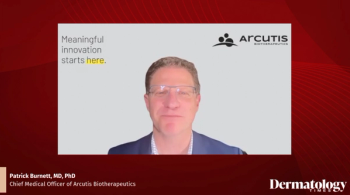
Lightening up: Advances, new combo laser increase options for port wine stains
Modifications in existing laser technology and a combination laser can help treat various types of port-wine stains more effectively than in the past, according to Jeffrey Dover, MD,FRCPC, a dermatologist with SkinCare Physicians, of Chestnut Hill, Mass.
Key Points
Although the pulsed dye laser is primary therapy, other laser and light-based devices, such as long-pulsed 532 nm lasers, long-pulsed Nd:YAG lasers, intense pulsed light devices and a combination pulsed dye laser and long-pulsed Nd:YAG laser can be used to treat stubborn, thick, large or nodular port wine stains.
"Early results with a combination of the pulsed dye laser and a long-pulsed Nd:YAG laser have been very promising," Dr. Dover says, noting the long-pulsed Nd:YAG laser requires increased skill and must be used judiciously.
Port wine stains occur in about three out of 1,000 people, according to the National Institutes of Health.
Laser therapy has been the most successful at reducing or eliminating the stains. The lasers destroy the tiny blood vessels in the skin without significantly damaging the skin.
Dr. Dover treats both adults and children with port wine stains.
"We prefer to treat children before school age to lighten the port wine stain dramatically, so no one ever knows they had one," Dr. Dover tells Dermatology Times.
Older patients are also coming in for treatment.
"I have been noticing lately that I have seen quite a few adults with port wine stains.
"Some of these patients have never had treatment, and others have tried previous treatments with the argon laser years ago or the pulsed dye laser, more recently, and stopped because of unpleasant side effects, such as scarring or pain, or poor results," he says.
Therapy includes a series of treatments, which varies depending on patient's age, type of port wine stain and type of laser used.
Original investigations suggested that most port wine stains cleared totally in a matter of six treatments.
It has become evident that far more treatments - 12 or more - are needed to achieve good results, and complete clearing of port wine stains is rare.
Substantial lightening, however, can be expected in most cases with treatments performed every two to six weeks.
Primary therapy
The gold standard of treatment for flat or slightly raised port wine stains in adults and children is still the pulsed dye laser.
"Several modifications have improved the pulsed dye laser, including cooling (usually in the form of cryogen cooling or air cooling).
Other options include the pulsed 532 nm lasers and intense pulsed light devices.
"However, the majority of experts would select the pulsed dye laser as their first choice of therapy.
"Intense pulsed light and pulsed 532 nm lasers would be used in circumstances where the pulsed dye laser has not been effective, or in certain situations where that is all that is available in the region of the country.
Newsletter
Like what you’re reading? Subscribe to Dermatology Times for weekly updates on therapies, innovations, and real-world practice tips.


















